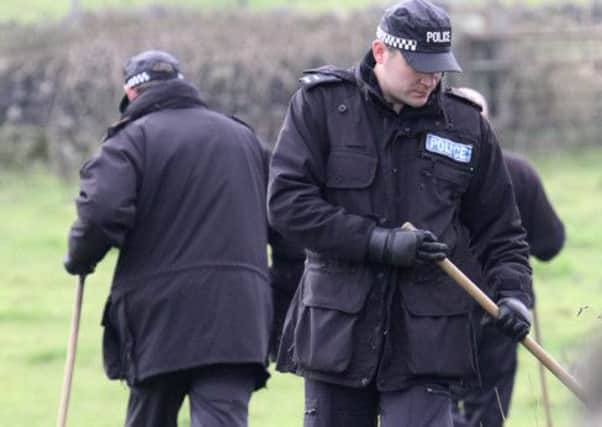Will Derbyshire’s unknown dead ever be identified?


He is believed to have committed suicide by overdosing on tuinal capsules but sadly, four decades later, his identity is still unknown.
This man is one of four cases in Derbyshire where bodies have been found but police have not yet been able to identify exactly who these people are.
Advertisement
Hide AdAdvertisement
Hide AdBuxton Section Inspector Martin Coey, who has many years’ experience dealing with missing persons, said it was difficult for officers to trace the identity of such people as they could have come to Derbyshire from other areas.
“With Derbyshire being a beauty spot, we actually get a lot of people travelling here who are depressed,” he said.
“It is surprising how many people come to this area in such situations. You tend to find when people are depressed they like to go somewhere they were happy and they often go to beauty spot areas or places that were significant to them in the past.”
He added: “In these cases we take DNA samples and it is all recorded on the national DNA database but then if someone hasn’t got a criminal record, we wouldn’t have their DNA on record to match.
“And of course, some people are never reported missing.
Advertisement
Hide Ad“It can be a very long and hard investigation in these circumstances. With any deceased person we will conduct a full investigation into the circumstances. We’ll act as coroner’s officers and assist the coroner with the investigation into what led to somebody’s death. We’ll look at the circumstances and then the coroner will decide the cause of death.”
Advertisement
Hide AdDetails of the deceased person are circulated to police forces nationally, as well as to other agencies, and even Interpol. But the task of finding out who they are is never an easy one.
“We have to work forwards and backwards,” Inspector Coey said. “When we have a missing person, we need to know everything about that person to try and get in their mind and find out where they might have gone. But if somebody’s body is found, we have to work backwards from them.
“We do a lot forensically and the advances in forensics are incredible when you look at how far we’ve come even in the last ten years. Advances in DNA mean we can now even tell the colour of people’s eyes in some cases. And this of course is why you see cold cases where people have been convicted of crimes 30 years ago because of all the advances that have been made.”
Advertisement
Hide AdHe added: “The cases of these unidentified bodies are very sad but it is very difficult to get to the bottom of it all when you have so little information and the people could have come from anywhere.”
Officers believe the man found at Topley Pike in 1971, who was aged between 45 and 55, may possibly have been German. He was wearing a Lovat Hepworth Driback raincoat, a brown suit, blue sweater and striped shirt. The man, who wore a trilby hat, had a surgical scar on his left upper back, and needlemark scars on his left arm. He had a birth mark on his right upper leg and a wart on his left finger. He was also lacking upper and lower teeth.
Advertisement
Hide AdOf medium build, the man was of White European ethnicity. He had dark brown, greying hair.
Not all of the cases are from so long ago. On July 14, 1996, a man was found in a sleeping bag close to a railway embankment at Stanton, near Ashbourne. The man, who was aged between 40 and 50, had an unkempt appearance.
Advertisement
Hide AdOf thin build, he was 168 centimetres tall, with dark brown, collar-length hair. He had facial hair which was greying, and was wearing a blue jumper and jeans. The only possessions found were an old duvet quilt or sleeping bag.
In 1977, the body of a man aged between 20 and 40 was found in the false roof of some partially constructed flats in Bakewell. It is believed he was diabetic as insulin was found with his body. It is also believed he had been dead approximately three weeks when discovered.
Described as being White European, the man had dark brown receding hair and a full beard. His eyes were brown and he wore a black donkey jacket with Tartan lining, a maroon shirt, blue jeans which were patched and worn and black calf length zip-up boots. He was also wearing a brown and tan scarf and a camouflage hat.
Advertisement
Hide AdIn his possession were a rail ticket dated July 3, 1975, from Inverness to Kyle of Lochalsh, a plastic wallet containing a Led Zeppelin ticket for July 24, 1975, at Earl’s Court in London and a Bang and Olufsen radio.
Advertisement
Hide AdOn October 6, 1989, a man was found hanging from a tree in an isolated location at Bank Hey Top, Derwent Valley.
Aged between 30 and 40, he was 173cm to 178cm tall, of slim build and with dark brown straight hair. Clean shaven, he had blue eyes and was wearing a khaki coloured Lee Cooper denim jacket. He was also wearing khaki colour cotton trousers, brown two-tone walking boots, a blue, cream and white checked shirt, a cream woollen jumper and a blue Peter Storm kagoul. In his possessions were a Karrimor rucksack, Thomas Hardy novel - Group of Noble Dames, two Manchester City council bin liners and a wallet containing £135 cash.